Social Control Theory: An Analysis of Curbing Youth Crime Essay
VerifiedAdded on 2023/06/17
|7
|2148
|271
Essay
AI Summary
This essay provides a comprehensive analysis of social control theory, examining its key concepts, strengths, and weaknesses, with a specific focus on its application in curbing youth crime. The essay discusses how social bonds, including attachment, commitment, involvement, and belief, contribute to an individual's self-control and reduce the likelihood of criminal behavior. It also addresses criticisms of the theory, such as its potential to overlook crimes committed by individuals with strong social connections and the influence of societal inequalities. The essay concludes by evaluating the usefulness of social control theory in understanding and addressing youth crime, emphasizing its role in promoting ethical behavior and building resilience within communities. Desklib provides access to this and other solved assignments for students.
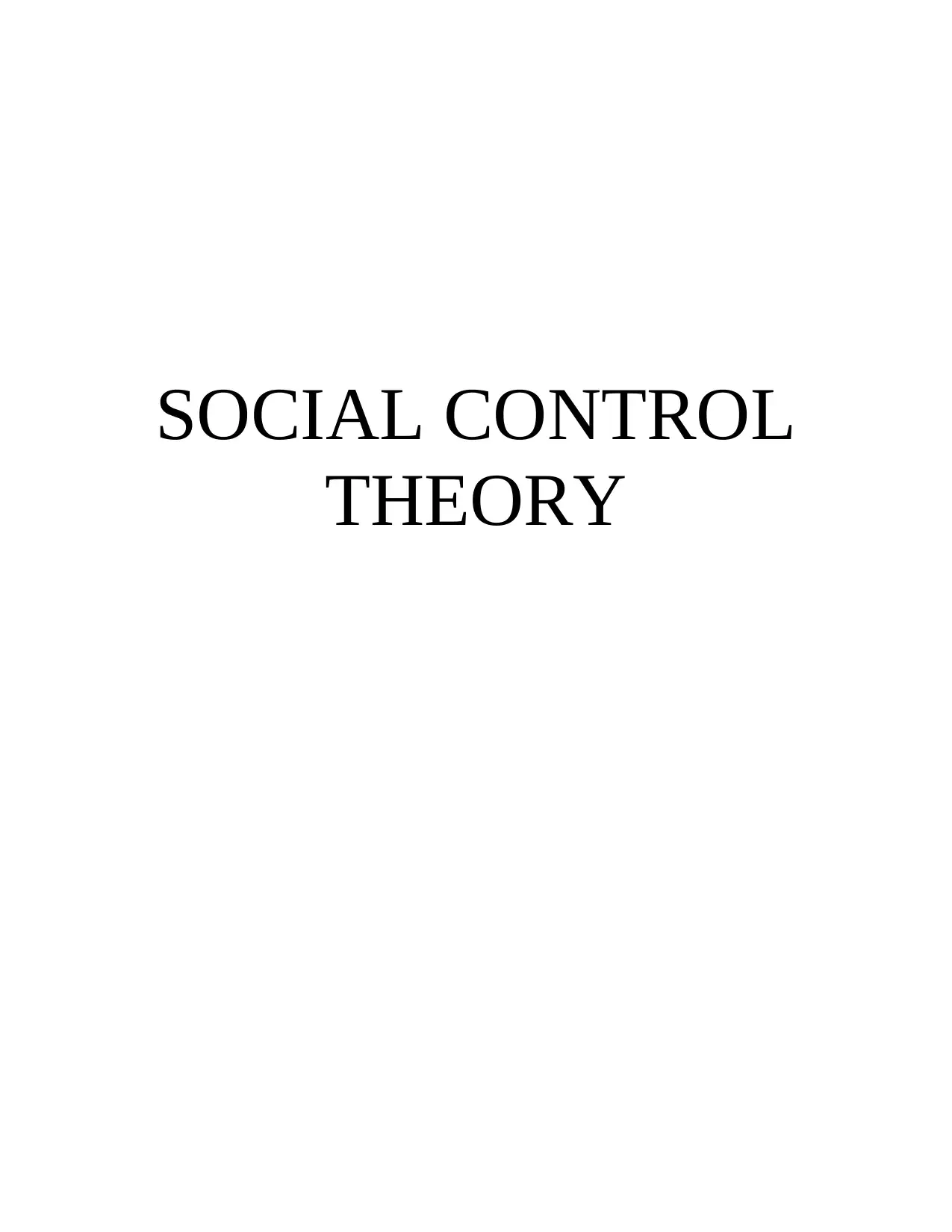
SOCIAL CONTROL
THEORY
THEORY
Paraphrase This Document
Need a fresh take? Get an instant paraphrase of this document with our AI Paraphraser

Table of Contents
INTRODUCTION...........................................................................................................................3
MAIN BODY...................................................................................................................................3
CONCLUSION................................................................................................................................6
REFERENCES................................................................................................................................7
INTRODUCTION...........................................................................................................................3
MAIN BODY...................................................................................................................................3
CONCLUSION................................................................................................................................6
REFERENCES................................................................................................................................7
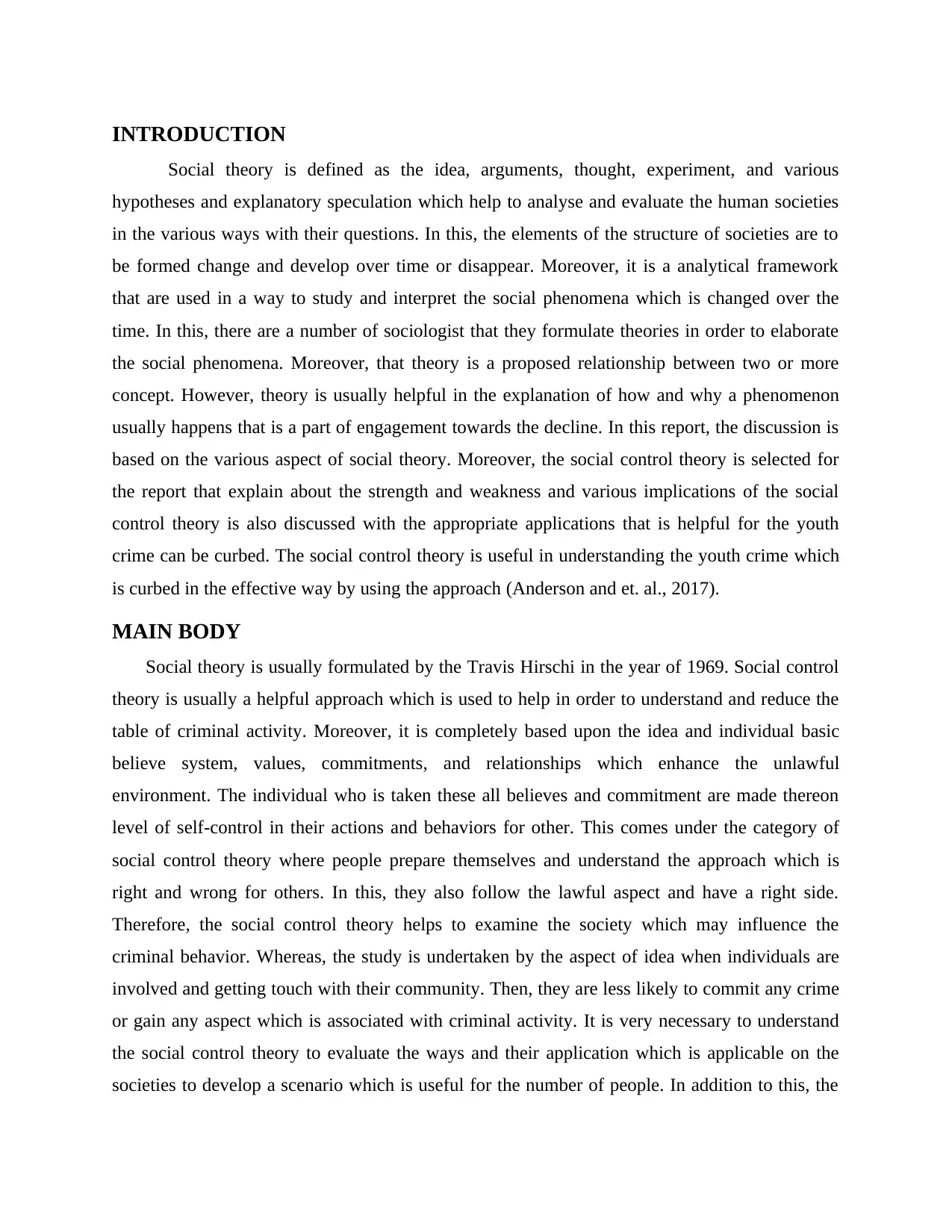
INTRODUCTION
Social theory is defined as the idea, arguments, thought, experiment, and various
hypotheses and explanatory speculation which help to analyse and evaluate the human societies
in the various ways with their questions. In this, the elements of the structure of societies are to
be formed change and develop over time or disappear. Moreover, it is a analytical framework
that are used in a way to study and interpret the social phenomena which is changed over the
time. In this, there are a number of sociologist that they formulate theories in order to elaborate
the social phenomena. Moreover, that theory is a proposed relationship between two or more
concept. However, theory is usually helpful in the explanation of how and why a phenomenon
usually happens that is a part of engagement towards the decline. In this report, the discussion is
based on the various aspect of social theory. Moreover, the social control theory is selected for
the report that explain about the strength and weakness and various implications of the social
control theory is also discussed with the appropriate applications that is helpful for the youth
crime can be curbed. The social control theory is useful in understanding the youth crime which
is curbed in the effective way by using the approach (Anderson and et. al., 2017).
MAIN BODY
Social theory is usually formulated by the Travis Hirschi in the year of 1969. Social control
theory is usually a helpful approach which is used to help in order to understand and reduce the
table of criminal activity. Moreover, it is completely based upon the idea and individual basic
believe system, values, commitments, and relationships which enhance the unlawful
environment. The individual who is taken these all believes and commitment are made thereon
level of self-control in their actions and behaviors for other. This comes under the category of
social control theory where people prepare themselves and understand the approach which is
right and wrong for others. In this, they also follow the lawful aspect and have a right side.
Therefore, the social control theory helps to examine the society which may influence the
criminal behavior. Whereas, the study is undertaken by the aspect of idea when individuals are
involved and getting touch with their community. Then, they are less likely to commit any crime
or gain any aspect which is associated with criminal activity. It is very necessary to understand
the social control theory to evaluate the ways and their application which is applicable on the
societies to develop a scenario which is useful for the number of people. In addition to this, the
Social theory is defined as the idea, arguments, thought, experiment, and various
hypotheses and explanatory speculation which help to analyse and evaluate the human societies
in the various ways with their questions. In this, the elements of the structure of societies are to
be formed change and develop over time or disappear. Moreover, it is a analytical framework
that are used in a way to study and interpret the social phenomena which is changed over the
time. In this, there are a number of sociologist that they formulate theories in order to elaborate
the social phenomena. Moreover, that theory is a proposed relationship between two or more
concept. However, theory is usually helpful in the explanation of how and why a phenomenon
usually happens that is a part of engagement towards the decline. In this report, the discussion is
based on the various aspect of social theory. Moreover, the social control theory is selected for
the report that explain about the strength and weakness and various implications of the social
control theory is also discussed with the appropriate applications that is helpful for the youth
crime can be curbed. The social control theory is useful in understanding the youth crime which
is curbed in the effective way by using the approach (Anderson and et. al., 2017).
MAIN BODY
Social theory is usually formulated by the Travis Hirschi in the year of 1969. Social control
theory is usually a helpful approach which is used to help in order to understand and reduce the
table of criminal activity. Moreover, it is completely based upon the idea and individual basic
believe system, values, commitments, and relationships which enhance the unlawful
environment. The individual who is taken these all believes and commitment are made thereon
level of self-control in their actions and behaviors for other. This comes under the category of
social control theory where people prepare themselves and understand the approach which is
right and wrong for others. In this, they also follow the lawful aspect and have a right side.
Therefore, the social control theory helps to examine the society which may influence the
criminal behavior. Whereas, the study is undertaken by the aspect of idea when individuals are
involved and getting touch with their community. Then, they are less likely to commit any crime
or gain any aspect which is associated with criminal activity. It is very necessary to understand
the social control theory to evaluate the ways and their application which is applicable on the
societies to develop a scenario which is useful for the number of people. In addition to this, the
⊘ This is a preview!⊘
Do you want full access?
Subscribe today to unlock all pages.

Trusted by 1+ million students worldwide
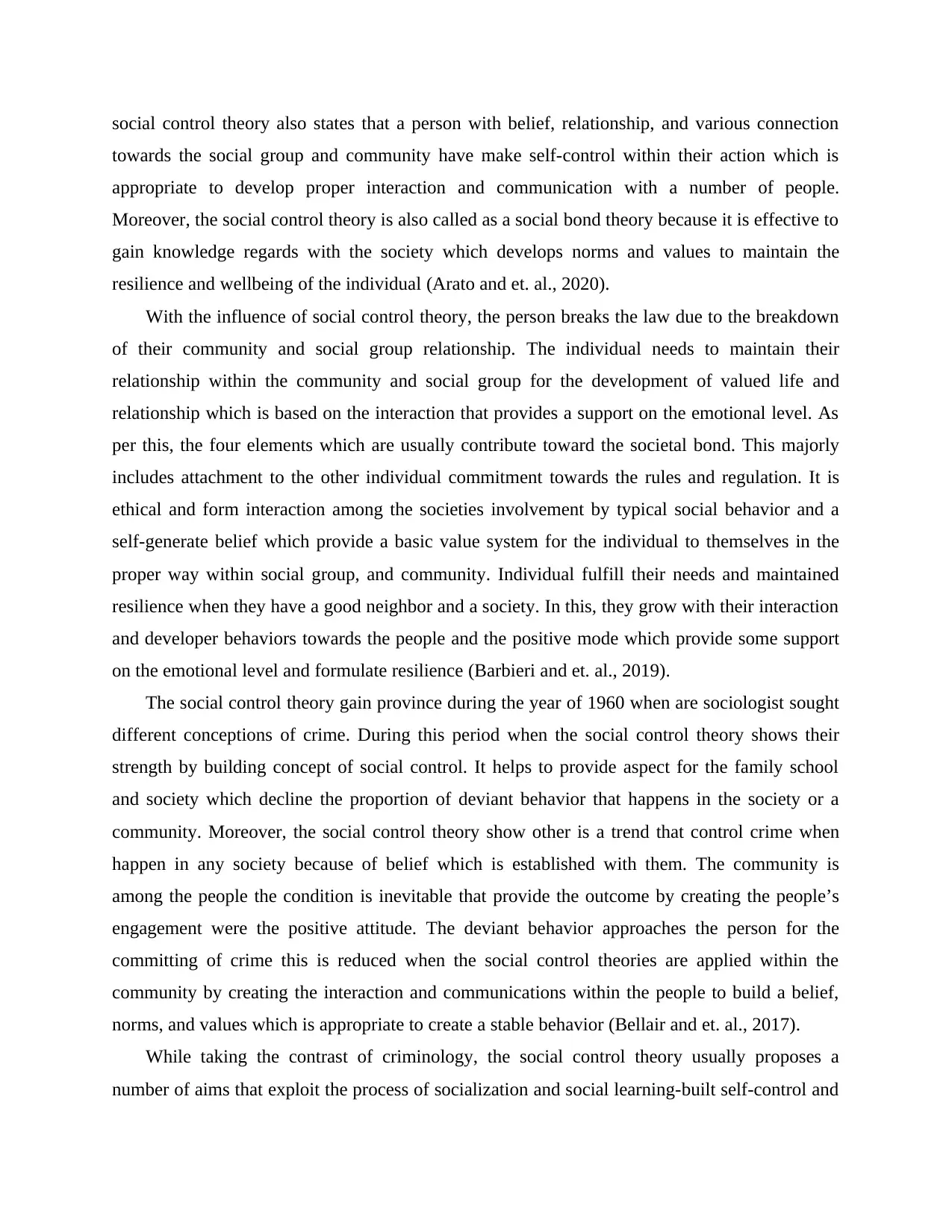
social control theory also states that a person with belief, relationship, and various connection
towards the social group and community have make self-control within their action which is
appropriate to develop proper interaction and communication with a number of people.
Moreover, the social control theory is also called as a social bond theory because it is effective to
gain knowledge regards with the society which develops norms and values to maintain the
resilience and wellbeing of the individual (Arato and et. al., 2020).
With the influence of social control theory, the person breaks the law due to the breakdown
of their community and social group relationship. The individual needs to maintain their
relationship within the community and social group for the development of valued life and
relationship which is based on the interaction that provides a support on the emotional level. As
per this, the four elements which are usually contribute toward the societal bond. This majorly
includes attachment to the other individual commitment towards the rules and regulation. It is
ethical and form interaction among the societies involvement by typical social behavior and a
self-generate belief which provide a basic value system for the individual to themselves in the
proper way within social group, and community. Individual fulfill their needs and maintained
resilience when they have a good neighbor and a society. In this, they grow with their interaction
and developer behaviors towards the people and the positive mode which provide some support
on the emotional level and formulate resilience (Barbieri and et. al., 2019).
The social control theory gain province during the year of 1960 when are sociologist sought
different conceptions of crime. During this period when the social control theory shows their
strength by building concept of social control. It helps to provide aspect for the family school
and society which decline the proportion of deviant behavior that happens in the society or a
community. Moreover, the social control theory show other is a trend that control crime when
happen in any society because of belief which is established with them. The community is
among the people the condition is inevitable that provide the outcome by creating the people’s
engagement were the positive attitude. The deviant behavior approaches the person for the
committing of crime this is reduced when the social control theories are applied within the
community by creating the interaction and communications within the people to build a belief,
norms, and values which is appropriate to create a stable behavior (Bellair and et. al., 2017).
While taking the contrast of criminology, the social control theory usually proposes a
number of aims that exploit the process of socialization and social learning-built self-control and
towards the social group and community have make self-control within their action which is
appropriate to develop proper interaction and communication with a number of people.
Moreover, the social control theory is also called as a social bond theory because it is effective to
gain knowledge regards with the society which develops norms and values to maintain the
resilience and wellbeing of the individual (Arato and et. al., 2020).
With the influence of social control theory, the person breaks the law due to the breakdown
of their community and social group relationship. The individual needs to maintain their
relationship within the community and social group for the development of valued life and
relationship which is based on the interaction that provides a support on the emotional level. As
per this, the four elements which are usually contribute toward the societal bond. This majorly
includes attachment to the other individual commitment towards the rules and regulation. It is
ethical and form interaction among the societies involvement by typical social behavior and a
self-generate belief which provide a basic value system for the individual to themselves in the
proper way within social group, and community. Individual fulfill their needs and maintained
resilience when they have a good neighbor and a society. In this, they grow with their interaction
and developer behaviors towards the people and the positive mode which provide some support
on the emotional level and formulate resilience (Barbieri and et. al., 2019).
The social control theory gain province during the year of 1960 when are sociologist sought
different conceptions of crime. During this period when the social control theory shows their
strength by building concept of social control. It helps to provide aspect for the family school
and society which decline the proportion of deviant behavior that happens in the society or a
community. Moreover, the social control theory show other is a trend that control crime when
happen in any society because of belief which is established with them. The community is
among the people the condition is inevitable that provide the outcome by creating the people’s
engagement were the positive attitude. The deviant behavior approaches the person for the
committing of crime this is reduced when the social control theories are applied within the
community by creating the interaction and communications within the people to build a belief,
norms, and values which is appropriate to create a stable behavior (Bellair and et. al., 2017).
While taking the contrast of criminology, the social control theory usually proposes a
number of aims that exploit the process of socialization and social learning-built self-control and
Paraphrase This Document
Need a fresh take? Get an instant paraphrase of this document with our AI Paraphraser
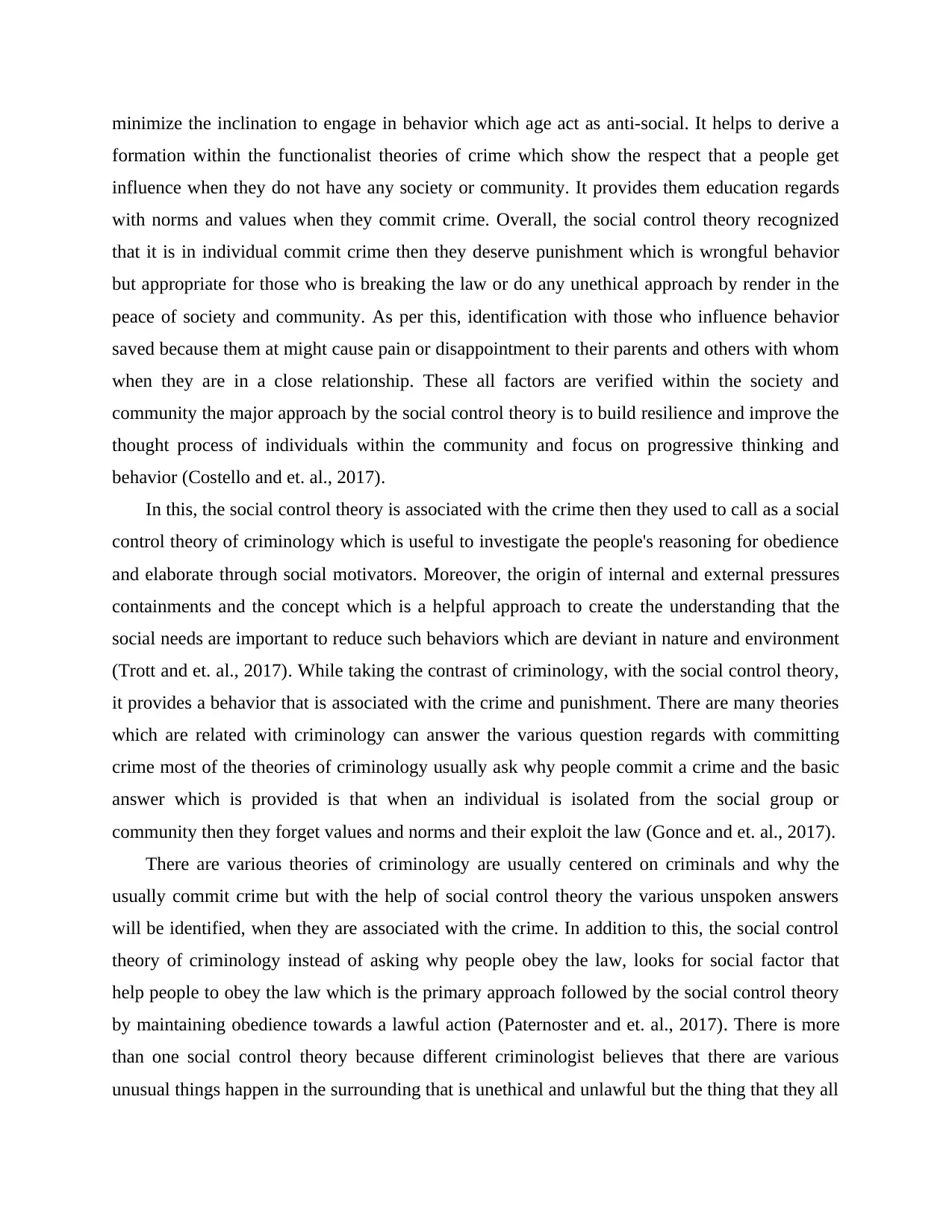
minimize the inclination to engage in behavior which age act as anti-social. It helps to derive a
formation within the functionalist theories of crime which show the respect that a people get
influence when they do not have any society or community. It provides them education regards
with norms and values when they commit crime. Overall, the social control theory recognized
that it is in individual commit crime then they deserve punishment which is wrongful behavior
but appropriate for those who is breaking the law or do any unethical approach by render in the
peace of society and community. As per this, identification with those who influence behavior
saved because them at might cause pain or disappointment to their parents and others with whom
when they are in a close relationship. These all factors are verified within the society and
community the major approach by the social control theory is to build resilience and improve the
thought process of individuals within the community and focus on progressive thinking and
behavior (Costello and et. al., 2017).
In this, the social control theory is associated with the crime then they used to call as a social
control theory of criminology which is useful to investigate the people's reasoning for obedience
and elaborate through social motivators. Moreover, the origin of internal and external pressures
containments and the concept which is a helpful approach to create the understanding that the
social needs are important to reduce such behaviors which are deviant in nature and environment
(Trott and et. al., 2017). While taking the contrast of criminology, with the social control theory,
it provides a behavior that is associated with the crime and punishment. There are many theories
which are related with criminology can answer the various question regards with committing
crime most of the theories of criminology usually ask why people commit a crime and the basic
answer which is provided is that when an individual is isolated from the social group or
community then they forget values and norms and their exploit the law (Gonce and et. al., 2017).
There are various theories of criminology are usually centered on criminals and why the
usually commit crime but with the help of social control theory the various unspoken answers
will be identified, when they are associated with the crime. In addition to this, the social control
theory of criminology instead of asking why people obey the law, looks for social factor that
help people to obey the law which is the primary approach followed by the social control theory
by maintaining obedience towards a lawful action (Paternoster and et. al., 2017). There is more
than one social control theory because different criminologist believes that there are various
unusual things happen in the surrounding that is unethical and unlawful but the thing that they all
formation within the functionalist theories of crime which show the respect that a people get
influence when they do not have any society or community. It provides them education regards
with norms and values when they commit crime. Overall, the social control theory recognized
that it is in individual commit crime then they deserve punishment which is wrongful behavior
but appropriate for those who is breaking the law or do any unethical approach by render in the
peace of society and community. As per this, identification with those who influence behavior
saved because them at might cause pain or disappointment to their parents and others with whom
when they are in a close relationship. These all factors are verified within the society and
community the major approach by the social control theory is to build resilience and improve the
thought process of individuals within the community and focus on progressive thinking and
behavior (Costello and et. al., 2017).
In this, the social control theory is associated with the crime then they used to call as a social
control theory of criminology which is useful to investigate the people's reasoning for obedience
and elaborate through social motivators. Moreover, the origin of internal and external pressures
containments and the concept which is a helpful approach to create the understanding that the
social needs are important to reduce such behaviors which are deviant in nature and environment
(Trott and et. al., 2017). While taking the contrast of criminology, with the social control theory,
it provides a behavior that is associated with the crime and punishment. There are many theories
which are related with criminology can answer the various question regards with committing
crime most of the theories of criminology usually ask why people commit a crime and the basic
answer which is provided is that when an individual is isolated from the social group or
community then they forget values and norms and their exploit the law (Gonce and et. al., 2017).
There are various theories of criminology are usually centered on criminals and why the
usually commit crime but with the help of social control theory the various unspoken answers
will be identified, when they are associated with the crime. In addition to this, the social control
theory of criminology instead of asking why people obey the law, looks for social factor that
help people to obey the law which is the primary approach followed by the social control theory
by maintaining obedience towards a lawful action (Paternoster and et. al., 2017). There is more
than one social control theory because different criminologist believes that there are various
unusual things happen in the surrounding that is unethical and unlawful but the thing that they all
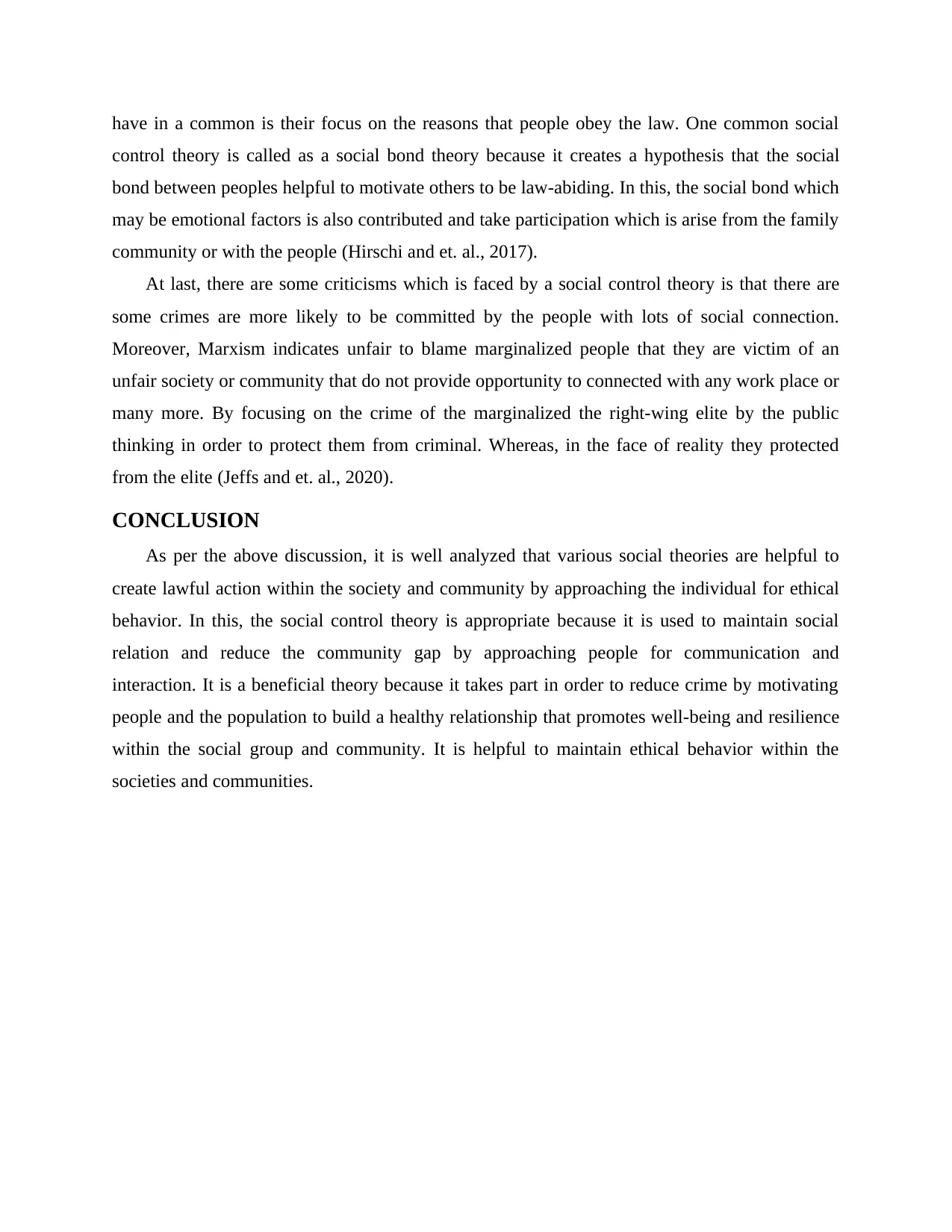
have in a common is their focus on the reasons that people obey the law. One common social
control theory is called as a social bond theory because it creates a hypothesis that the social
bond between peoples helpful to motivate others to be law-abiding. In this, the social bond which
may be emotional factors is also contributed and take participation which is arise from the family
community or with the people (Hirschi and et. al., 2017).
At last, there are some criticisms which is faced by a social control theory is that there are
some crimes are more likely to be committed by the people with lots of social connection.
Moreover, Marxism indicates unfair to blame marginalized people that they are victim of an
unfair society or community that do not provide opportunity to connected with any work place or
many more. By focusing on the crime of the marginalized the right-wing elite by the public
thinking in order to protect them from criminal. Whereas, in the face of reality they protected
from the elite (Jeffs and et. al., 2020).
CONCLUSION
As per the above discussion, it is well analyzed that various social theories are helpful to
create lawful action within the society and community by approaching the individual for ethical
behavior. In this, the social control theory is appropriate because it is used to maintain social
relation and reduce the community gap by approaching people for communication and
interaction. It is a beneficial theory because it takes part in order to reduce crime by motivating
people and the population to build a healthy relationship that promotes well-being and resilience
within the social group and community. It is helpful to maintain ethical behavior within the
societies and communities.
control theory is called as a social bond theory because it creates a hypothesis that the social
bond between peoples helpful to motivate others to be law-abiding. In this, the social bond which
may be emotional factors is also contributed and take participation which is arise from the family
community or with the people (Hirschi and et. al., 2017).
At last, there are some criticisms which is faced by a social control theory is that there are
some crimes are more likely to be committed by the people with lots of social connection.
Moreover, Marxism indicates unfair to blame marginalized people that they are victim of an
unfair society or community that do not provide opportunity to connected with any work place or
many more. By focusing on the crime of the marginalized the right-wing elite by the public
thinking in order to protect them from criminal. Whereas, in the face of reality they protected
from the elite (Jeffs and et. al., 2020).
CONCLUSION
As per the above discussion, it is well analyzed that various social theories are helpful to
create lawful action within the society and community by approaching the individual for ethical
behavior. In this, the social control theory is appropriate because it is used to maintain social
relation and reduce the community gap by approaching people for communication and
interaction. It is a beneficial theory because it takes part in order to reduce crime by motivating
people and the population to build a healthy relationship that promotes well-being and resilience
within the social group and community. It is helpful to maintain ethical behavior within the
societies and communities.
⊘ This is a preview!⊘
Do you want full access?
Subscribe today to unlock all pages.

Trusted by 1+ million students worldwide
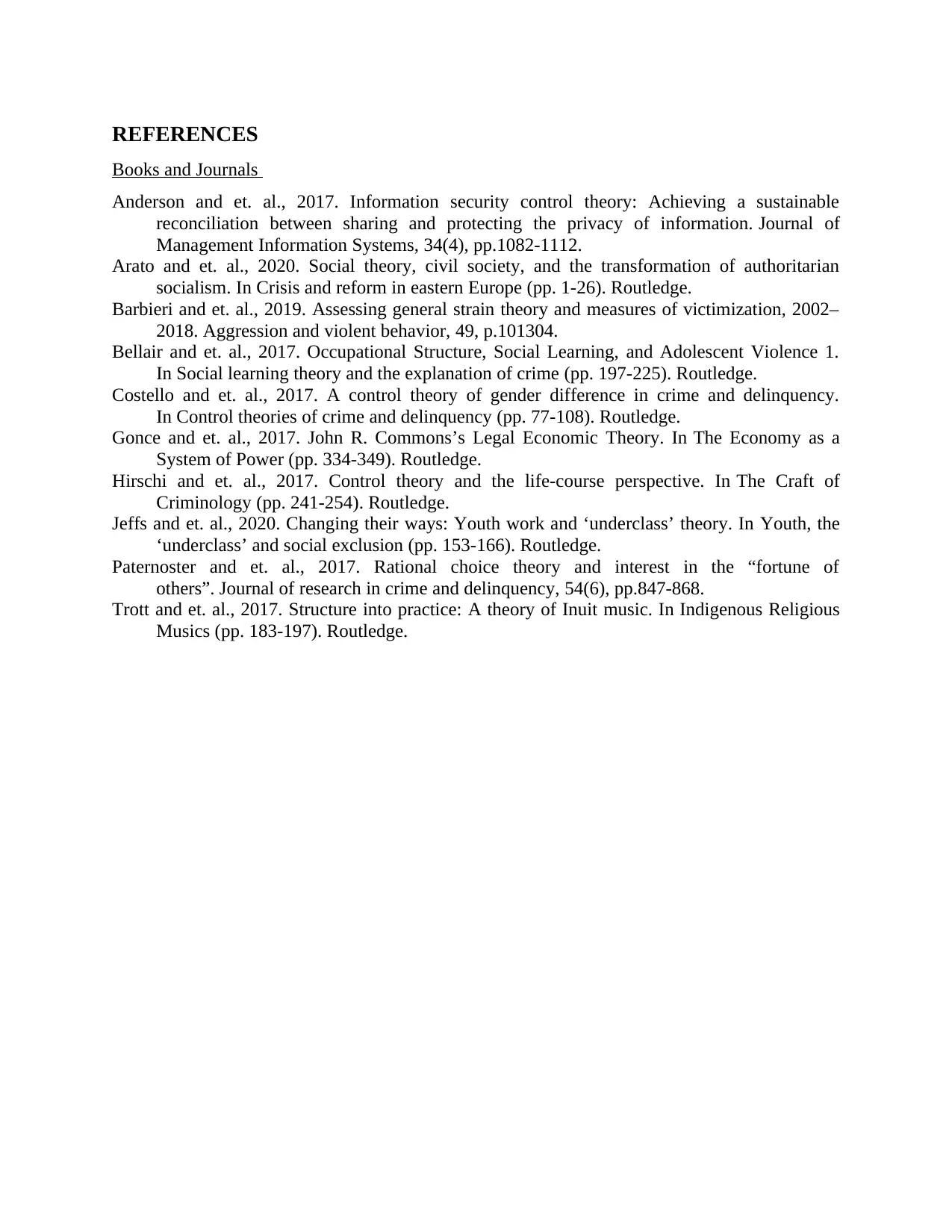
REFERENCES
Books and Journals
Anderson and et. al., 2017. Information security control theory: Achieving a sustainable
reconciliation between sharing and protecting the privacy of information. Journal of
Management Information Systems, 34(4), pp.1082-1112.
Arato and et. al., 2020. Social theory, civil society, and the transformation of authoritarian
socialism. In Crisis and reform in eastern Europe (pp. 1-26). Routledge.
Barbieri and et. al., 2019. Assessing general strain theory and measures of victimization, 2002–
2018. Aggression and violent behavior, 49, p.101304.
Bellair and et. al., 2017. Occupational Structure, Social Learning, and Adolescent Violence 1.
In Social learning theory and the explanation of crime (pp. 197-225). Routledge.
Costello and et. al., 2017. A control theory of gender difference in crime and delinquency.
In Control theories of crime and delinquency (pp. 77-108). Routledge.
Gonce and et. al., 2017. John R. Commons’s Legal Economic Theory. In The Economy as a
System of Power (pp. 334-349). Routledge.
Hirschi and et. al., 2017. Control theory and the life-course perspective. In The Craft of
Criminology (pp. 241-254). Routledge.
Jeffs and et. al., 2020. Changing their ways: Youth work and ‘underclass’ theory. In Youth, the
‘underclass’ and social exclusion (pp. 153-166). Routledge.
Paternoster and et. al., 2017. Rational choice theory and interest in the “fortune of
others”. Journal of research in crime and delinquency, 54(6), pp.847-868.
Trott and et. al., 2017. Structure into practice: A theory of Inuit music. In Indigenous Religious
Musics (pp. 183-197). Routledge.
Books and Journals
Anderson and et. al., 2017. Information security control theory: Achieving a sustainable
reconciliation between sharing and protecting the privacy of information. Journal of
Management Information Systems, 34(4), pp.1082-1112.
Arato and et. al., 2020. Social theory, civil society, and the transformation of authoritarian
socialism. In Crisis and reform in eastern Europe (pp. 1-26). Routledge.
Barbieri and et. al., 2019. Assessing general strain theory and measures of victimization, 2002–
2018. Aggression and violent behavior, 49, p.101304.
Bellair and et. al., 2017. Occupational Structure, Social Learning, and Adolescent Violence 1.
In Social learning theory and the explanation of crime (pp. 197-225). Routledge.
Costello and et. al., 2017. A control theory of gender difference in crime and delinquency.
In Control theories of crime and delinquency (pp. 77-108). Routledge.
Gonce and et. al., 2017. John R. Commons’s Legal Economic Theory. In The Economy as a
System of Power (pp. 334-349). Routledge.
Hirschi and et. al., 2017. Control theory and the life-course perspective. In The Craft of
Criminology (pp. 241-254). Routledge.
Jeffs and et. al., 2020. Changing their ways: Youth work and ‘underclass’ theory. In Youth, the
‘underclass’ and social exclusion (pp. 153-166). Routledge.
Paternoster and et. al., 2017. Rational choice theory and interest in the “fortune of
others”. Journal of research in crime and delinquency, 54(6), pp.847-868.
Trott and et. al., 2017. Structure into practice: A theory of Inuit music. In Indigenous Religious
Musics (pp. 183-197). Routledge.
1 out of 7
Related Documents
Your All-in-One AI-Powered Toolkit for Academic Success.
+13062052269
info@desklib.com
Available 24*7 on WhatsApp / Email
![[object Object]](/_next/static/media/star-bottom.7253800d.svg)
Unlock your academic potential
Copyright © 2020–2025 A2Z Services. All Rights Reserved. Developed and managed by ZUCOL.





